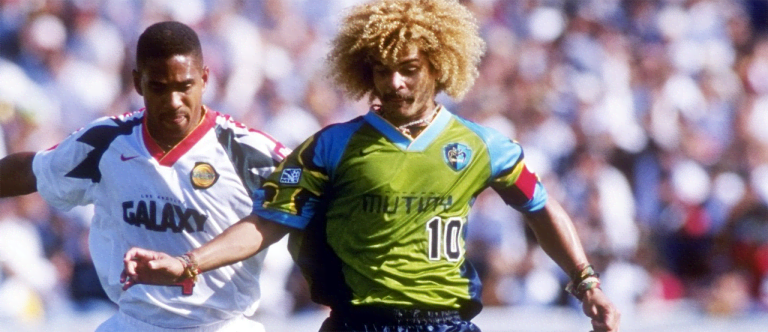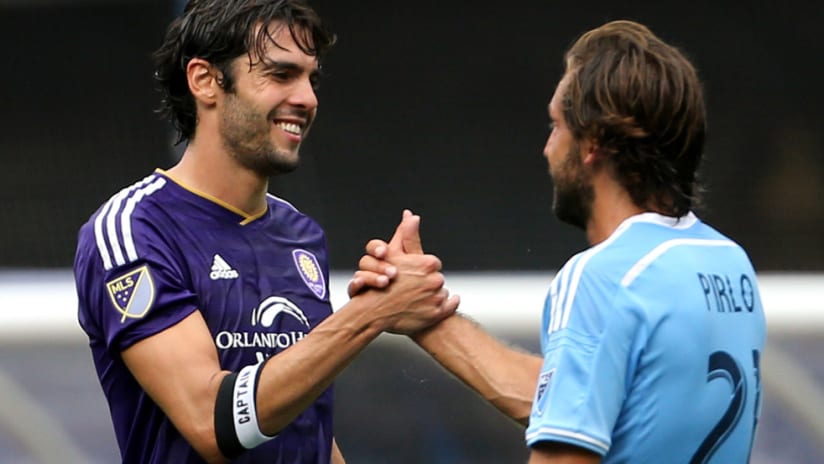Here’s the line on Andrea Pirlo’s final game as a professional: Six touches, two horribly errant crosses and six minutes of extra-time substitute duty as NYCFC bowed out of the playoffs prematurely for a second straight season.
Ouch. Not how any of us want to remember arguably the classiest central midfielder of his generation. So let’s look at his finale in a different light.
Mark this down: Pirlo’s exit from the professional game – coupled with Kaká’s final MLS game last month – marks the official end of the Megastar Signing Era in Major League Soccer. And this, on the other hand, is an incredibly good thing. I’m not the only one who feels this way.
“Ten years from now,” ESPN’s Taylor Twellman tells MLSsoccer.com, “if the league keeps going in this direction, 2017 will be the year it changed.”
Plenty of glitter, no gold
Let’s back up for minute and qualify what we’re talking about. I’m not here to suggest MLS teams will stop signing expensive European or South American players who will move the needle on the field. The Designated Player Rule – in whatever form it takes in the coming years – is here to stay. There needs to be a financial mechanism for MLS clubs to bring in these sorts of players, whatever their individual strategy is for employing them.
But the days of forking out eight-figure, multi-year deals for the most recognizable names in the game – players like David Beckham, Thierry Henry, David Villa, Pirlo and Kaká, with their trophy cases overstuffed with FIFA Player of the Year awards, Ballon d’Ors and World Cup and UEFA Champions League medals – are coming to a stark end.
This doesn’t just date back to David Beckham’s signing as the first-ever DP back in 2007. You can go back to the ill-fated Lothar Matthäus signing by the MetroStars in 1999, or back to the very beginning, when MLS brought in Jorge Campos and Carlos Valderrama. All of the above had one thing in common: Their performance on the field was really secondary. They were signed to signal to a North American audience, “We’re here! We’re worth your attention!”

Whether these players were acquired to help bring credibility to a new league, a new club or to plant a flag in a larger market with a crowded sporting landscape, the name recognition was the primary goal. Bringing their teams actual trophies? That would’ve been a nice bonus, too.
And it’s been, for the most part, an ultimately futile one. If you look back at the on-field successes by teams with megastars on their roster, very few have actually won anything significant. In fact, the LA Galaxy were the first club with a DP on its roster to win MLS Cup – four long years after they signed Beckham. It took Henry until his fifth and final year in a New York Red Bulls jersey to win a major title (and it’s debatable whether a single Supporters’ Shield can be considered an on-field “success”).
New generation of stars taking over
This is not to suggest big-name DPs have been a waste of money – far from it. Besides the credibility and recognition mentioned above, there’s also the matter of a healthy stream of jersey sales and sponsorship revenue, as well as global exposure. By that metric, you’d have to argue these signings have been a success.
But clubs have also learned their lessons from devoting too much of their payroll to one player at the expense of their record. And they’ve also learned how to play the salary-cap game to bring in younger, more effective players who help them win.
To wit, the average age of DPs who are new to the league (i.e. not re-signed players), has been steadily decreasing since the rule’s institution 10 years ago. In 2007, a year that saw Beckham and Cuauhtémoc Blanco join MLS, the average DP was a shade older than 32. By 2013, that average age was down to 26. And after a brief increase back up to the 28 range, it settled back down to 26 again this year.
Year |
# of DPs |
Avg. Age |
|---|---|---|
2007 |
5 |
32.4 |
2008 |
3 |
32.0 |
2009 |
5 |
30.0 |
2010 |
10 |
30.2 |
2011 |
16 |
28.9 |
2012 |
14 |
30.1 |
2013 |
16 |
26.1 |
2014 |
21 |
28.5 |
2015 |
28 |
27.9 |
2016 |
13 |
27.8 |
2017 |
26 |
26.3 |
The trend has been twofold: 1) It makes little financial sense to keep adding huge names as every team in MLS has steadily moved toward filling all of the three permitted DP slots and 2) younger, mid-level talent is becoming more available than it ever has.
The first point seems obvious, and it’s why you see teams like, for instance, the Galaxy totally reverse course after the bloat of Beckham, Robbie Keane and Landon Donovan raking in more than three-quarters of the entire team’s payroll. Even traditional high spenders like Seattle and New York have been slowly readjusting their finances. (Toronto are probably the last outliers for the time being, with Sebastian Giovinco, Michael Bradley and Jozy Altidore all on huge deals.)
The second point is the newer phenomenon. MLS is becoming destination – or at least a stepping stone – to a whole new generation of players. It’s why a new club like Atlanta United went out of its way to sign young, dynamic attackers like Miguel Almirón and Josef Martínez, two players who, in the old days, wouldn’t give the league a second look. Sounders president and GM Garth Lagerwey believes a lot of that is due to the fact that MLS games are now available on TV in 170 countries around the globe.
“As the world has gotten smaller, you see more touchstones for American culture reaching further,” he explains to MLSsoccer.com. “Layer over that access to MLS and you have millennial players who say, ‘That looks like a lot of fun.’ That’s the complex that has changed. We’re getting access to those players. So given the choice of a 32-year-old version of that player and a 25-year-old version, you take [the latter].”

In short, MLS is, for the most part, getting out of the business of recruiting existing stars and entering the business of cultivating them – or at least elevating them – while in their prime. No one will dispute that Giovinco or Almirón weren’t tremendous talents coming into the league. But now that breed of players has the opportunity to become standouts in a league far from home, where they can showcase their talents to their respective national teams and, in some cases, chase bigger opportunities, should they choose to do so. (I would include in this list in-their-prime Americans and Canadians, such as Bradley, Paul Arriola or Samuel Piette – but I could write an entirely separate column on this phenomenon.)
Take, for example, both Western Conference finalists. Houston have on their books three DPs in Erick “Cubo” Torres, Alberth Elis and Tomás Martínez, all relatively cost-effective players 24 years old or younger. Seattle may be their polar opposite in terms of spending, but last summer landed an in-his-prime Uruguayan international in Nicolás Lodeiro, a prototype of a player who probably wouldn’t have had MLS on his radar 10 years ago.
That said, the era isn’t completely dead – not quite yet. David Villa is still a top performer for NYCFC, even in the late stages of his career. Bastian Schweinsteiger may be back in Chicago next season, while Carlos Vela is a few months from first kick for LAFC. And if Zlatan Ibrahimovic is somehow available in January, I’d put money on him finally landing in the league – to say nothing of a Lionel Messi or a Cristiano Ronaldo eventually deciding he’d like to kick the tires on MLS.
As Lagerwey explains, “In a major market like a New York or an LA, when you have 11 professional teams plus college sports, there could be an argument that you need to appeal to a demographic with a big star. And when you’re opening a new building or launching a new franchise, you only get one chance to make a first impression.”
But the simple math here is that there’s a very finite list of players like Messi, Ronaldo and Zlatan – and that list is getting thinner without Pirlo and Kaká.
Finding the next Almirón, Giovinco, Diego Valeri or Albert Rusnák? It’s not an infinite list by any means, but those players are the future of MLS. Now it’s up to the league to grab them first.













